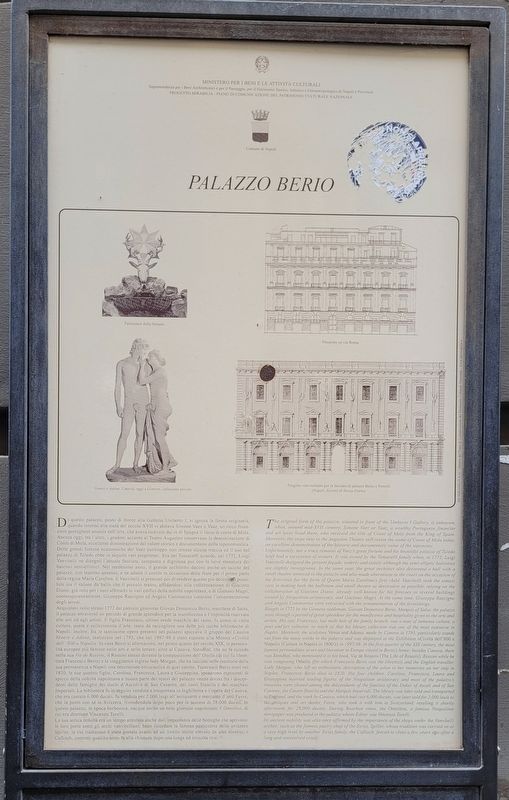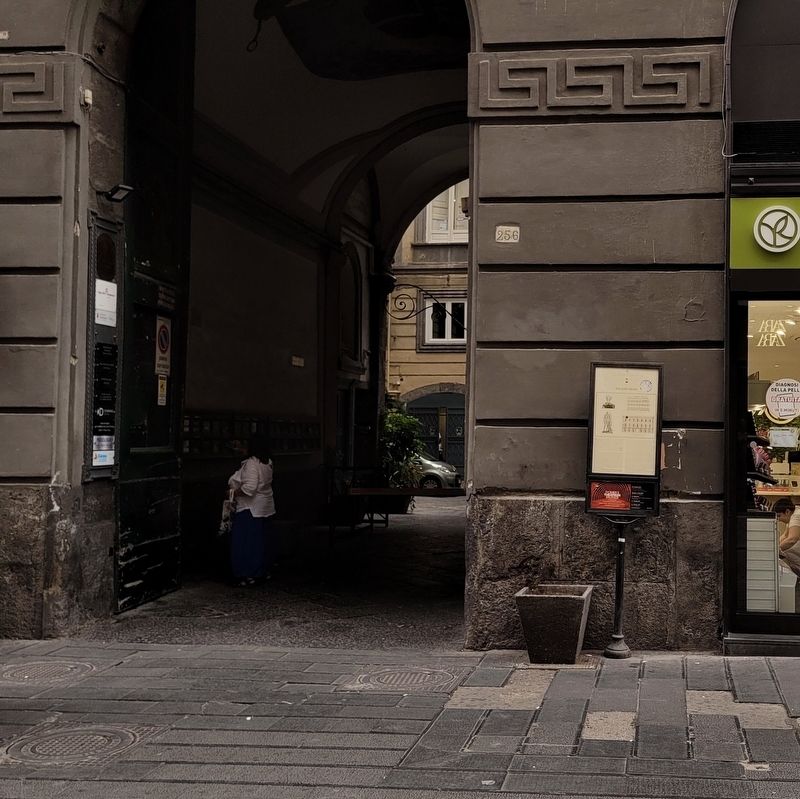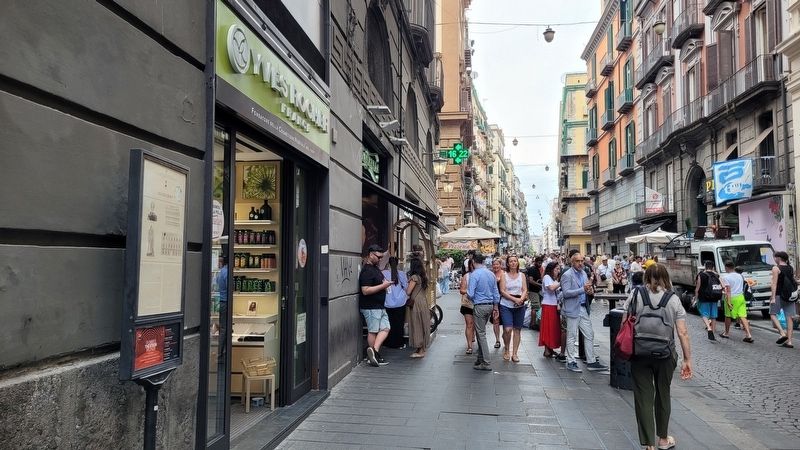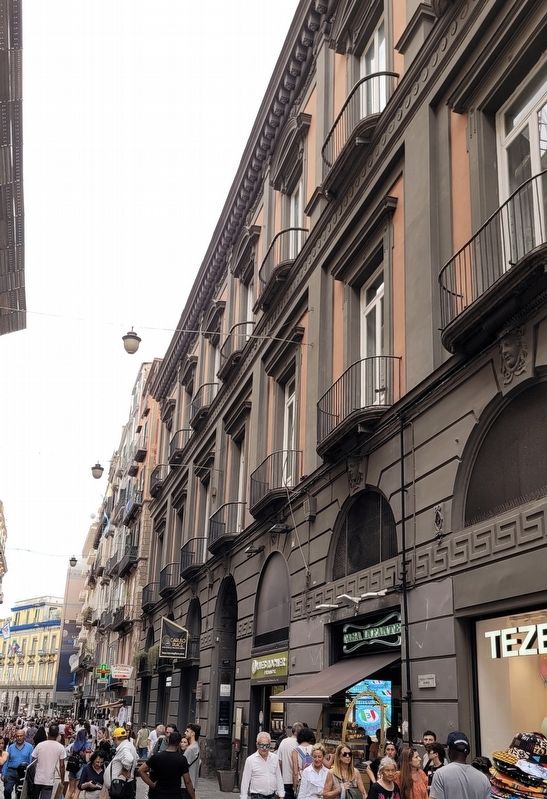Quartieri Spagnoli in Napoli in Città Metropolitana di Napoli, Campania, Italy — Southern Italy (Tyrrhenian Coast)
Palazzo Berio / Berio Palace
Acquistato nello stesso 1772 dal patrizio genovese Giovan Domenico Berio, marchese di Salsa, il palazzo attraverso un periodo di grande splendore per la munificenza e l'ospitalità riservata alle arti ed agli artisti. Il figlio Francesco, ultimo erede maschile del ramo, fu uomo di vasta cultura, poeta e collezionista d'arte, tanto da raccogliere una delle più ricche biblioteche di Napoli. Inoltre, fra le tantissime opere presenti nel palazzo spiccava il gruppo del Canova Venere e Adone, realizzato nel 1793, che nel 1997-98 è stato esposto alla Mostra Civiltà dell 800 a Napoli. In casa Berio si alternarono, nel primo quarto del secolo XIX, le personalità europee più famose nelle arti e nelle lettere: oltre al Canova, Stendhal, che ne fa ricordo nella sua Vie de Rossini, il Rossini stesso durante la composizione dell'Orello (di cui fu librettista Francesco Berio) e la viaggiatrice inglese lady Morgan, che ha lasciato nelle memorie della sua permanenza a Napoli una descrizione entusiastica di quel salotto. Francesco Berio mori nel 1820; le sue quattro figlie, Carolina, Francesca, Laura e Giuseppina, sposarono esponenti di spicco della nobiltà napoletana e buona parte dei tesori del palazzo
venne divisa fra i discendenti delle famiglie dei duchi d'Ascoli e di San Cesareo, dei conti Statella e dei marchesi Imperiali. La biblioteca fu in seguito venduta e trasportata in Inghilterra e l'opera del Canova, che era costata 6.000 ducati, fu venduta per 2.000 luigi all'antiquario e mercante d'arte Favre, che la portò con sé in Svizzera, rivendendola dopo poco per la somma di 28.000 ducati. In questo palazzo, in epoca borbonica, nacque anche un noto giornale napoletano, l'Omnibus, di cui era direttore Vincenzo Torelli.
La sua antica nobiltà era un tempo attestata anche dall'importanza delle botteghe che aprivano le loro porte sotto gli archi vanvitelliani: basti ricordare la famosa pasticceria dello svizzero Spiller, la cui tradizione è stata portata avanti ad un livello molto elevato da altri elvetici, i Caflisch, costretti qualche anno fa alla chiusura dopo una lunga ed irrisolta crisi.
Didascalie
Particolare della fontana
Venere e Adone, Canova, oggi a Ginevra, collezione privata
Prospetto su via Roma
Progetto vanvitellano per la faccias di palazzo Berio o Perrelli (Napoli, Società di Storia Patria)
The original form of the palazzo, situated in front of the Umberto I Gallery, is unknown, when, around mid-XVII century, Simone Vaez or Vaaz, a wealthy Portuguese financier and art lover lived there, who received the title of Count of Mola from the King of Spain. Moreover, the steps next to the Augustan Theatre still retain the name of Count of Mola today, an excellent demonstration of the historic and documentary value of the toponymy.
Unfortunately, not a trace remains of Vaez's great fortune and his beautiful palazzo of Toledo later had a succession of owners. It was owned by the Tomacelli family when, in 1772, Luigi Vanvitelli designed the present façade, orderly and stately although the semi-elliptic balconies are slightly incongruous. In the same year, the great architect also decorated a hall with a small theatre annexed in the palazzo and also made alterations to the court on the occasion of the festivities for the birth of Queen Maria Carolina's first child. Vanvitelli took the utmost care in making both the ballroom and small theatre as decorative as possible, relying on the collaboration of Giacinto Diano, already well-known for his frescoes in several buildings owned by Neapolitan aristocracy, and Gaetano Magri. At the same time, Giuseppe Rascigno and Angelo Cammarota were entrusted with the ornamentation of the furnishings. Bought in 1772 by the Genoese nobleman, Giovan Domenico Berio, Marquis of Salsa, the palazzo went through a period of great splendour for the munificence and hospitality given to the arts and artists. His son, Francesco, last male heir of the family branch, was a man of immense culture, a poet and art collector, so much so that his library collection was one of the most extensive in Naples. Moreover, the sculpture Venus and Adonis, made by Canova in 1793, particularly stands out from the many works in the palazzo and was displayed at the Exhibition Civiltà dell'800 a Napoli (Culture in Naples in 1800's) in 1997-98. In the first quarter of the XIX century, the most famous personalities in art and literature in Europe stayed in Berio's home: besides Canova, there was Stendhal, who mentioned it in his book, Vie de Rossini (The Life of Rossini). Rossini while he was composing Othello (for which Francesco Berio was the librettist) and the English traveller, Lady Morgan, who left an enthusiastic description of the salon in her memories on her stay in Naples. Francesco Berio died in 1820. His four children, Carolina, Francesca, Laura and Giuseppina married leading figures of the Neapolitan aristocracy and most of the palazzo's treasures were shared among the descendants of the families of the Dukes of Ascoli and of San Cesareo, the Counts Statella and the Marquis Imperiali. The library was later sold and transported to England, and the work by Canova, which had cost 6,000 ducats, was later sold for 2,000 louis to the antiques and art dealer, Favre, who took it with him to Switzerland, reselling it shortly afterwards for 28,000 ducats. During Bourbon times, the Omnibus, a famous Neapolitan newspaper was produced in the palazzo whose Editor was Vincenzo Torelli.
Its ancient nobility was also once affirmed by the importance of the shops under the Vanvitelli arches: such as the famous pastry shop of the Swiss, Spiller, whose tradition was carried on at a very high level by another Swiss family, the Caflisch, forced to close a few years ago after a long and unresolved crisis.
Captions
Detail of the fountain
Venus and Adonis, Canova, now in Geneva, private collection
Prospectus on via Rome
Vanvitella project for the facade of Palazzo Berio or Perrelli (Napoli, National History Society)
Erected by Ministero Per I Beni E Le Attività Culturali, Soprintendenza per i Beni Architettonici e per il Paesaggio, per il Patrimonio Storico Artistico e Demoetnoantropologico di Napoli e Provincia, Progetto Mirabilia Piano di Comunicazione del Patrimonio Culturale Nazionale and Comune di Napoli.
Topics. This historical marker is listed in these topic lists: Architecture • Arts, Letters, Music • Industry & Commerce. A significant historical year for this entry is 1772.
Location. 40° 50.318′ N, 14° 14.899′ E. Marker is in Napoli, Campania, in Città Metropolitana di Napoli. It is in Quartieri Spagnoli. Marker is at the intersection of Via Toledo and Vico Berio, on the left when traveling north on Via Toledo. The marker is located at the right side of the entrance to the building. Touch for map. Marker is at or near this postal address: Via Toledo 257, Napoli, Campania 80132, Italy. Touch for directions.
Other nearby markers. At least 8 other markers are within walking distance of this marker. Galleria Umberto I (a few steps from this marker); Palazzo Cirella / Cirella Palace (within shouting distance of this marker); Chiesa di S. Ferdinando / Church of S. Ferdinando (about 120 meters away, measured in a direct line); Palazzo Zevallos Stigliano / Zevallos Stigliano Palace (about 150 meters away); Palazzo Salerno e Gambrinus / Salerno and Gambrinus Palace (about 180 meters away); Il Caffè Sospeso / The Suspended Coffee (about 210 meters away); Palazzo Reale / Royal Palace (about 210 meters away); Basilica di S. Francesco di Paola / Basilica of St. Francis of Paola (approx. 0.3 kilometers away). Touch for a list and map of all markers in Napoli.
Credits. This page was last revised on July 19, 2023. It was originally submitted on July 17, 2023, by James Hulse of Medina, Texas. This page has been viewed 95 times since then and 41 times this year. Photos: 1, 2, 3, 4. submitted on July 19, 2023, by James Hulse of Medina, Texas.



